 German Empire – 113 submersible planned, 25 comp.* UC-90 to UC-114
German Empire – 113 submersible planned, 25 comp.* UC-90 to UC-114WW1 German U-Boats
Brandtaucher | Forelle | U-1 | U-2 | U-3 class | U-5 class | U-9 class | U-13 class | U-17 class | U-19 class | U-23 class | U-43 class | U-57 class | U-63 class | U-87 class | U-93 class | U-139 class | U-142 class | UA | UB-I class | UB-II class | UB-III class | UC-I class | UC-II class | UC-III | Deutschland | UE-I class | UE-II class | U-ProjectsType UC III minelaying submarines were designred and built for the Kaiserliche Marine (Imperial German Navy)in World War I. They were largely inspired by the contemporary UB-III in size, albeit smaller at 474/571 t and in addition to a deck gun and 7 torpedoes they also carried 14 mines. They improved on the successful UC-II by their double-hull, extra range and sea-keeping, seagoing, maneuvering agility to the price of lower underwater stability. Great hopes were placed in this class with all the fundings dedicated to the class in 1917, with a total of 113 UC III ordered but only 25 completed before the Armistice in 1918, 16 in service for a few months or weeks, 59 built total, 54 cancelled in 1918, 9 completed post-armistice and 34 never completed, BU on slip. The design proved instrumental to rebuilt the late interwar U-Boat arm, notably with the UB-IIIs they were considered the ancestors of the Type VII though the I.V.S (covert Hague design bureau) export subs.
Design genesis of the UC-III
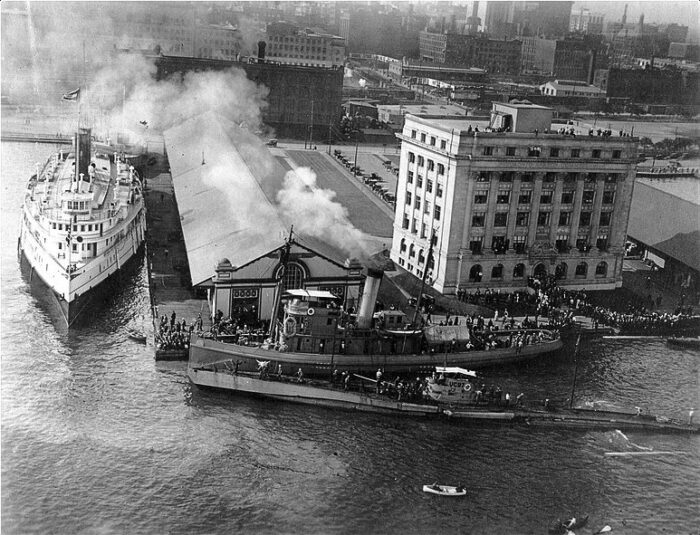
SM UC 97 in Toronto postwar, as a war prize
To understand the UC-III development it is important to go back and have a look at its ancestors, the UC-I and II. First off, the idea of minelayer submarines was not new, and it was Russian in origin, designed by Mikhail Petrovich Nalyotov. “Krab”, ordered in 1908, was the world’s first submarine minelayer, completed in 1915, before the German UC-I class which encountered delays. Krab could lay a full minefield of 60 mines, stored of two horizontal galleries and exiting through the stern. She was already a large model at 740 tonnes submerged, perhaps too large for Baltic Operations. By contrast, the UC-I type was more in line with the UB-II design, made for the Baltic shallow waters and north sea at 168/183 t surf/submerged. 15 were built, all capable of carrying six oblique 1 meter (39 in) mine tubes forward, to lay down 12 UC-120 mines (two per tubes). They were too small to have a torpedo tube and had a crew of 14. Losses were heavy, so a successor was soon design with better performances and size: The UC-II class.
The type UC II minelaying submarines displaced 417 tons wuth a deck gun and two external, one internal torpedo tube (7 torpedoes) six internal chutes for three miens each, so 18 smaller UC-200 in all. They were also double-hulled, had improved range, agility, speed and seakeeping. In fact they performed so well that 64 were ordered and completed, and if judged only by their indirect or direct kills (1800+), they remains today the most successful submarine design in history. Still, with that numbers of submarines, numerous reports piled up to help the naval staff improving on the seemingly ideal recipe. The last in class, UC-79, was launched on 19 December 1916 and commissioned on 22 January 1917. In between an improved design was already worked on in 1916. Some aspects would be kept and other improved. It should be also noted that the German also deplioyed oceanic (Atlantic) minelaying subs, the UE class (19) carrying 42 mines. The UC boats were more coastal in nature.
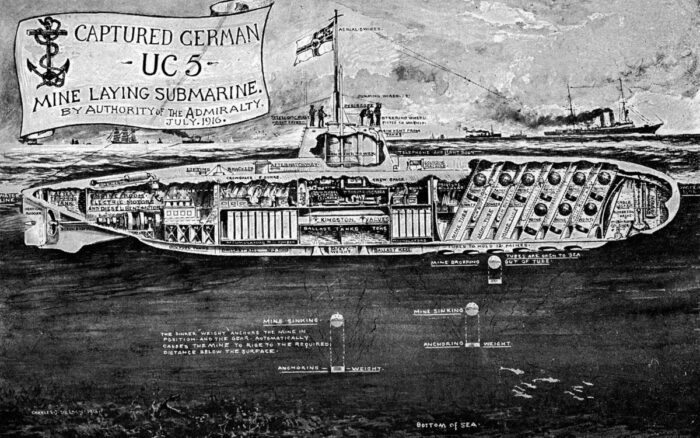
Scheme explaining UC-I minelaying operations, 1916 from the captured UC-5
Final design
Design work proceeded late in 1916 and as approved FY1917, with an order of 200, later brought back to 113. They were larger designs at 491/571 t versus 434/511 t for the late UC-II, with an improved fouble hull for more oil tank capacity, the hull shape was refined, but the same combo of three tubes, two external, one internal was kept, the internal one being at the stern and reloadable while submerged. Seven torpedoes were carried, just as for the UC-II. They also had the same six 100 cm (39.4 in) mine tubes but for fourteen, not sixteen UC 200 mines. Some compromises were made in order to gain extra range. The protubering forward hull section notably was now integrated flush with the rest of the hull which shape was much refined, and partly inspired by the UB-III class.
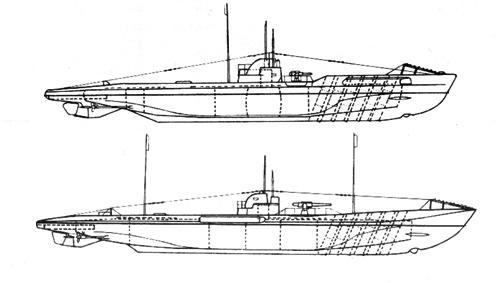
Comparison between the UC-II and UC-III types (src uboat.net).
The electric powerplant was also improved albeit they kept the same diesel, but the speeds remained about the same, albeit with longer underwater range. Surfaced range was the greatest improvement from 7300 to 9800 nm, albeit on par with the late UC-II designs. Many technical parts were also shared with the UB-IIIs. It should be reminded that at this stage of the war, the UB-III had been ordered to 200 (production started in late 1916), so combined with 113 UC-III this made for a combined 313 subs sharing many similarities in design to gain the advantage of mass production. The result was the UC-III unit Cost was 3,303,000 German paper marks, 3,654,000 for an UB-III. The Kaiserliches Marine bet everything to win the war at sea on these two types.
The lessons were not forgotten and in WW2, the Type VIIC production was rapidly ramped up, whereas minelayer submarines were no longer a priority.
Hull Design
The Type UC III displaced 491 tonnes (483 long tons) surfaced, for 571 tonnes (562 long tons) submerged, with an overall length of 56.51 m (185 ft 5 in) [UC-II 49.35–53.15 m (161 ft 11 in – 174 ft 5 in) o/a] combined with a beam of 5.54 m (18 ft 2 in) [UC-II 5.22 m (17 ft 2 in)], draught of 3.77 m (12 ft 4 in) [UC-II 3.65 m (12 ft)]. Unfortunately UC-III are hard to come by, hope to display them if found. Their crew was the same as before with twenty-six crew members (three officers).
Powerplant and Performances
The UC-III were powered about the same way as the UC-IIn with two six-cylinder, four-stroke MAN diesel engines which were rated at 300 metric horsepower (220 kW; 300 shp) each for a total of 600 metric horsepower [440 kW; 590 shp]. However a large space was obtained to installed two beefier Siemens-Schuckert electric motors rated for 770 metric horsepower (570 kW; 760 shp) instead of 460–620 PS (340–460 kW; 450–610 shp) on the UC-II. This power was passed onto two propeller shafts sharing strusts and propellers with the UB-IIIs. Note that a Polis shource states there were Benz or Körting diesels but these were reserved for later incompleted boats.
Performances wise, diving time was much quicker at 15 seconds (48 sec. for an average UC-II) and were capable of operating under 75 metres (246 ft), versus 50 m (160 ft) for an UC-II. Top surface speed was 11.5 knots (21.3 km/h; 13.2 mph) [UC-II ] and a submerged speed of 6.6 knots (12.2 km/h; 7.6 mph) [UC-II ].
Surface range was 9,850 nautical miles (18,240 km; 11,340 mi) at 7 knots (13 km/h; 8.1 mph) [UC-II late type 9,410 nmi].
And 40 nautical miles (74 km; 46 mi) at 4.5 knots (8.3 km/h; 5.2 mph) submerged [UC-II late type 60 nmi/4 kts].
Note that the first batch UC-90 was the only cone completed but there were plans for longer boats with more powerful Benz or Korting diesels for extra surface speed. They were generously distributed among allies postwar.
Armament
The UC III-class boats were given six one meter (100 cm or 39 in) slanted mine tubes, for fourteen UC 200 mines, four less than the UC-II (see later). They also had three 50-centimetre (20 in) torpedo tubes. The stern one was internal, but the two at the bow were still external, albeit now better integrated into the outer hull. They were located on the deck amidships on both sides of the conning tower. Total was seven torpedoes. The problem with that system was that they needed to be surfaced to extract the spare torpedoes beneath the outer hull and good sea condition for that operation. It was found simpler to just turn the boat around to fire the stern tube and order a reload. The standard 8.8 cm deck gun was replaced by a 10.5 cm (4.1 in) SK L/4, albeit some were completed with a 8.8 cm (3.5 in) Uk L/30 deck gun due to shortages.
German standard Torpedoes
This was the 50 cm (19.7″) G/6 used on all U-boats from U-19 and by that stage the better G/6D
Designed in 1908 it entered service in 1911 and became standard.
⚙ Specs G6D* |
|
| Overall Length | 236 in (6.000 m) |
| Explosive Charge* | 362 lbs. (164 kg) TNT/Hexanitrodephenylamin (Hexanite) |
| Range/Speed | 9,190 yards (8,400 m)/27 knots or 3,830 yards (3,500 m)/35 knots |
| Power | Kerosene Wet-Heater |
8.8 cm (3.5 in) SK L/30
⚙ Specs G6 |
|
| Mass | 644 kilograms (1,420 lb) |
| Length | 2.64 meters (8 ft 8 in) |
| Shell | Fixed HE 7 kilograms (15 lb) 3.5 in |
| Breech | horizontal sliding-wedge |
| Elevation | Ubts.L: -10° to +30° |
| Rate of fire | 15 RPM |
| Muzzle velocity | 590 m/s (1,900 ft/s) |
| Max. range | Ubts.L: 10,500 metres (11,500 yd) at +30° |
10.5 cm (4.1 in) SK L/45
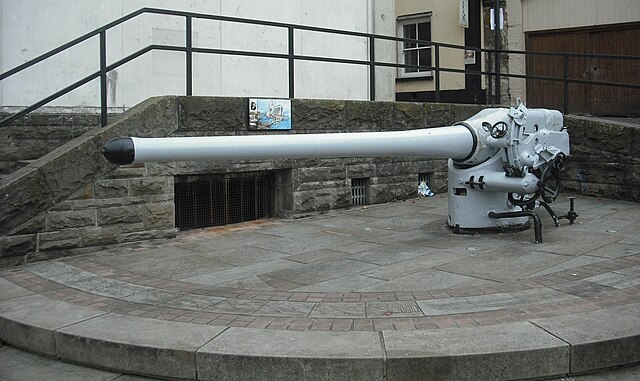
105 mm SK L/45 from UB-91 exposted at Chepstow
They were planned, but not installed on al boats. 150 rounds were provided.
⚙ Specs 10.5cm SK L/45 (4.1 in) |
|
| Overall mass | 1,450 kg (3,200 lb) |
| Length | 4.725 m (15 ft 6.0 in) |
| Shell | Fixed Brass Casing 25.5 kg (56 lb), shell 17.4 kg (38 lb) |
| Breech | Horizontal sliding-block |
| Elevation | Ubts LC/16: -10° to +50°, traverse 360° |
| Rate of fire | 15 RPM |
| Muzzle velocity | 710 m/s (2,300 ft/s) |
| Max. range 12,700 m (13,900 yd) at 30° | |
UC-200 mines
The UC boats used the same Moored Hertz horn contact mines. The UC/200 is not well documented, albeit many were captured by the RN from 1915 onwards. The UC/120 was a round 31.5 inches (80 cm) model, with a Wet gun guncotton charge, 290 lbs. (131 kg) and contact horn using acid lead. In UK classification, Type II. The Type III and IV are understood as variant of the UC/200. Also designed for submarine minelayers of the German Navy the UC/200 was developed as a successor to the UC/120 by mid-1915, intended for the almost vertical mine launchers of UC II and UC III tubes. They could be moored at a depth of up to 20 meters, down to 100 meters. The first model weighted 620 lbs. (281 kg), 34 inches (86 cm) but with a Cast TNT 220 lbs. (100 kg) charge and the Type IV, same mass and size but Wet gun guncotton; 180 lbs. (81.6 kg) charge. Other sources gives 200 kg, mine alone, 281 with the anchor below. A reference for Italian mines for the UC/200 model 1921 gives a charge of 441 lbs. (200 kg) and a 330 foot (100 m) mooring cable.
Profile awaited.
⚙ UC-III specifications |
|
| Displacement | 491 t (483 long tons) surfaced, 571 t (562 long tons) submerged |
| Dimensions | 56.51 x 5.54 x 3.77m (185 ft 5 in x 18 ft 2 in x 12 ft 4 in) |
| Propulsion | 2 shafts 6-cy. MAN diesels 600 PS, 2× Siemens EM 770 PS |
| Speed | 11.5 knots surfaced, 6.6 knots submerged |
| Range | 9,850 nm at 7 knots surfaced, 40 nmi at 4.5 knots submerged |
| Armament | 6× 100 cm mine tubes (14), 3 × 50 cm TTs (7), 1 × 10.5 cm SK L/45 deck gun |
| Test depth | 75 m (246 ft) |
| Crew | 32 |
Construction
The table below resumes the orders by builder.
⚙ Construction Yards |
|
| UC-80 to UC-86 BU slip, UC-139-152 cancelled | Danzig Naval Yard |
| UC-87-89 BU on slip | A.G. Weser, Bremen |
| UC-90 to UC-114, until UC-138 BU on slip and until UC-192 cancelled | Blohm & Voss, Hamburg |
Neither Germaniawerft, Kiel or Vulcan, Hamburg, already busy with the UB-III took part in the construction.
Blohm & Voss, Hamburg boats were launched from 19.1.18 to 11.8.18. UC 90 became the Japanese O 4 1918, BU 1921, UC 91 sank en route to surrender 10.2.19, UC 92 was BU 1921, UC 93 was BU 1919, UC 94 was BU 1919, UC 95 was BU 1922, UC 96 was BU 1919-20, UC 97 was granted to the USA, tested and sunk as target 7.6.21. UC 98 was BU 1919, UC 99 was granted to the Japanese, renamed O 5 in 1918, was tested and BU 1920-21. UC 100 was BU 1921, UC 101 was BU 1922, UC 102 was BU 1922, UC 103 was BU 1921, UC 104 was BU 1921, UC 105 was BU 1922, UC 106 was BU 1921, UC 107 was BU 1921, UC 108 was BU 1921, UC 109 was BU 1921, UC 110 sank en route to BU i 1921, UC 111 was BU 1921, UC 112 was BU 1921, UC 113 was BU 1921, UC 114 was BU 1921; UC 115 to UC 118 were BU on slips in 1918, UC 119 to UC 138 were BU on slips in 1919 and UC 153 to UC 192 had their orders cancelled.
These UC III type minelayers were a considerable improvement on their predecessors, and had a diving depth of 75m. Two TT were sited amidships but were forward-firing. They werethoroughly studied by the allies and saw little service. UC 9 was lost after an accident. All other surviving boats were distributed as follows: Britain got UC 92, UC 95, UC 101-UC 103, UC 105 to UC 106 and UC 108-UC 114 of which UC 110 was lost by accident during transfer. France got UC 100, UC 104 and UC 107 which were scrapped and Italy got UC 93, UC 94 and UC 98 which were soon scrapped. Japan got UC 90 and UC 99 and commissioned them as O 4 and O S$. The USA got UC 97 which was sunk as a gunnery practice target after having been put on public display. UC 80-UC 89 and UC 115-UC 138 were broken up unfinished on their slips in Germany after the war while the orders for UC 139-UC 192 were cancelled in 1918-19.
Caracteristics by series
Legacy of the UC-III
The UC-III types were instrumental at two levels. First, they were studied carefully by the entente powers postwar, UK, US, Japan, France and Italy, which all obtained some. Many ideas were adopted and a lot of features ended in new interwar submarines. But they were also important for other nations which ordered new submarines at the same period, notably Turkey, Spain, Finland, and USSR to secure the design of new submarines under the dummy NV Ingenieurskantoor voor Scheepsbouw founded on 21 July 1922 and financed by the Government for the Reichsmarine through Germaniawerft in Kiel, which led the team. The UB-III and UC-III were the starting point for these new designs, leading ultimately to the Type VII, the standard medium U-Boat of the Kriegsmarine from 1936. The UC-III design was used as a base for development to create notably the three Vetehinen-class, direct ancestors of the initial Type VII, albeit the Spanish E-1 from Echevarrieta y Larrinaga is also a possible origin.
The UB-III Type in service
Completed before the armistice
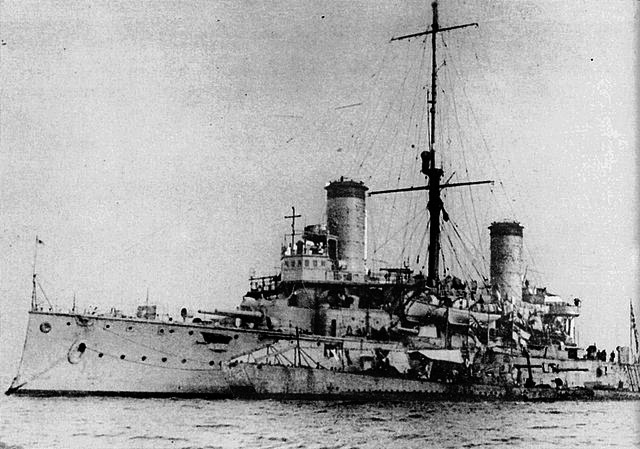
IJN Nisshin at Malta with captured German UC-90 U-boat, March 1919
 UC-90
UC-90
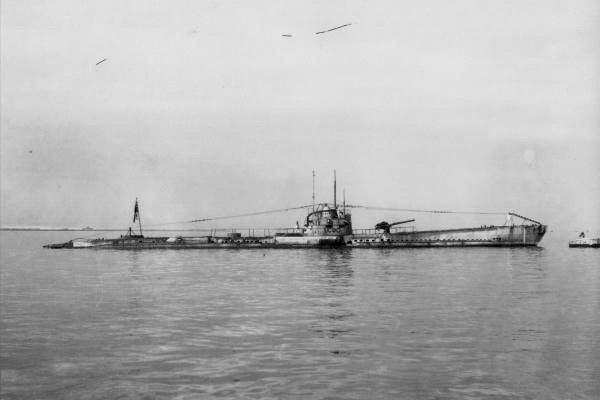
The UC-90 was ordered on 12 January 1916, launched on 19 January 1918 and she was commissioned on 15 July 1918. She did not had the time for any war patrols at tht stage and sank no ships, still traning in November. She was surrendered to Japan on 1 December 1918, renamed O-4 in IJN service, and used for evaluations from 1920 to 1921. In 1921 she was partially dismantled at Kure and from 1924 to 1926 her hulk became an ASW target, eventually sold for scrap.
 UC-91
UC-91
Ordered on 12 January 1916, launched on 19 January 1918, she was commissioned on 31 July 1918 and was still training in September, so no war patrols. While underway on 5 September with her green crew she collided with the steamer Alexandra Woermann in the Baltic Sea and foundered. She was raised on the 6th by the salvage vessel Vulkan, repaired but after the surrender, she was en route on 10 February 1919 when she she foundered in the North Sea.
 UC-92
UC-92
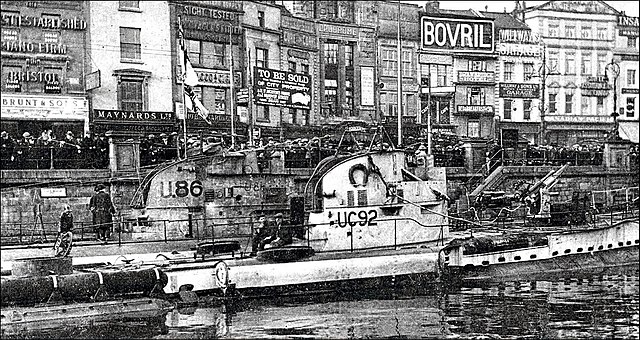
Uboats U-86 and UC-92 on exhibition in Bristol at the end of the war. Bristol Hippodrome can be seen in the background.
UC-91 was ordered on 12 January 1916, launched on 19 January 1918, commissioned on 14 August 1918, made no war patrol and was surrendered on 24 November. She was ceded to the British hands, exhibited at Bristol with SM U-86 then towed to Falmouth for explosive test trials in the bay to determine their weaknesses. On 7 March 1921, she was dumped on Castle Beach, sold to R. Roskelly & Rodgers, on 19 April 1921, partially salvaged over many years, the remnants in 1965-68. The wreck was still partially visible when ecxplored by divers of Wessex Archaeology in 2013 on the seabed. It was a popular attraction for local divers.
 UC-93
UC-93
UC-93 was ordered on 12 January 1916, launched on 19 February 1918, commissioned on 22 August 1918, surrendered on 26 November, ceded to Italy which tested her and broken up in La Spezia, in August 1919.
 UC-94
UC-94
UC-94 was ordered on 12 January 1916, launched on 19 February 1918, commissioned on 31 August 1918, surrendered on 26 November 1918, als attributed to Italy and BU in Taranto in April 1919.
 UC-95
UC-95
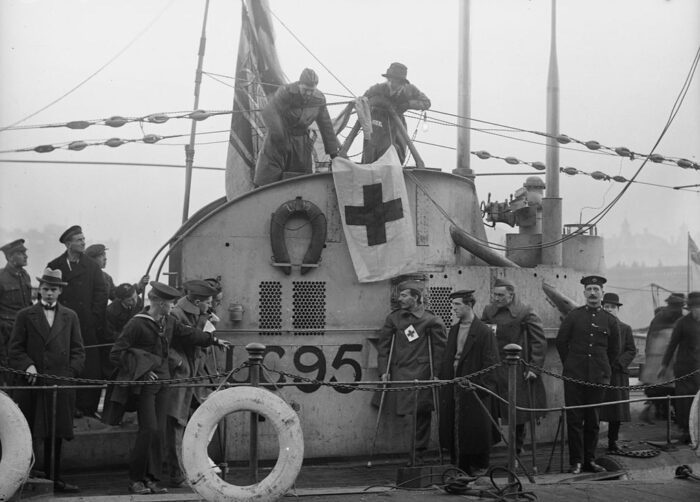
UC-95 was ordered on 12 January 1916 , launched on 19 February 1918, commissioned on 16 September 1918, surrendered on 22 November, attributed to UK and BU in Fareham, 1922.
 UC-96
UC-96
UC-96 was ordered on 12 January 1916, launched on 17 March 1918, commissioned on 25 September, surrendered on 24 November, attributed to UK, BU in Morecambe in 1919–20.
 UC-97
UC-97
UC-97 was ordered on 12 January 1916, launched on 17 March 1918, commissioned on 3 September 1918, surrendered on 22 November, attributed by the commissioned to the United States. She was part of the Ex-German Submarine “Expeditionary Force” with SM U-111, SM U-117, SM U-140, SM U-164, UB-88. The USN sent 12 officers and 120 ratings to man them, sent in Britain wit the goal to cross the Atlantic, to be exhibited to raising money for Liberty Bonds. UC-97 sailed from Harwich in April 1919 alongside U-111, U-164, and UB-88, escorted by USS Bushnell (AS-2) via the Azores and Bermuda and arrived for a show in New York City.
Later she was moved through St. Lawrence Seaway and to the Great Lakes under Charles A. Lockwood. multiplying port calls on lakes Ontario, Erie, Huron, and Michigan. However the German machinery became unreliable and Lockwood and his crew were replaced by another from the 9th Naval District. UC-97 ended in Monroe Street, Chicago’s lakefront Grant Park, open for tourists.
However a clause of the armistice treaty required her to be destroyed (as all war prize subs) before 1 July 1921. Armament, propulsion, navigation gear were removed. She was stripped off and towed out into Lake Michigan by USS Hawk (IX-14) and spent as target as part of the annual summer training for Midwestern reservists. USS Wilmette fired a 4 in (10 cm) and his her 18 times in 15 minutes, sinking her 20 nautical miles (37 km) off Highland Park on 7 June.
 UC-98
UC-98
UC-98 was ordered on 12 January 1916, launched on 17 March 1918, commissioned on 10 September 1918 as SM UC-98 under Heinz Stamer and trained until surrendered on 24 November 1918, ceded to Italy, BU in La Spezia in April 1919.
 UC-99
UC-99
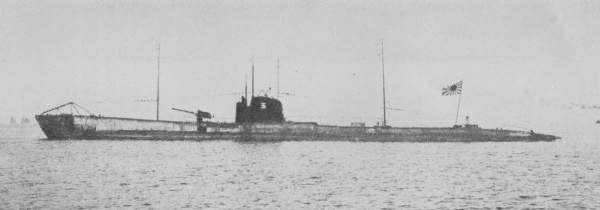
UC-99 was ordered on 12 January 1916, launched on 17 March 1918, commissioned on 20 September, surrendered, ceded to Japan on 22 November 1918, renamed O-5 and used for tests until 1921, dismantled at the Yokosuka Navy Yard in March-June, stripped and the hull finished off as gunnery and torpedo target in October.
 UC-100
UC-100
UC-100 was ordered on January 12, 1916, launched on April 14, 1918, commissioned on September 30, still training when surrendered to France on November 22, tested and BU in Cherbourg in July 1921.
 UC-101
UC-101
Ordered on 12 January 1916, UC-101 was launched on 14 April 1918, commissioned on 8 October, surrendered on 24 November, BU in Dordrecht in 1922.
 UC-102
UC-102
UC-102 was ordered on 12 January 1916, launched on 14 April 1918, commissioned on 14 October, surrendered on 22 November, BU in Dordrecht in 1922 (not attributed).
 UC-103
UC-103
UC-103 was ordered on 12 January 1916, launched on 14 April 1918, commissioned on 21 October, surrendered to France on 22 November, BU in Cherbourg in July 1921.
 UC-104
UC-104
UC-104 was ordered on 12 January 1916, launched on 25 May 1918, commissioned on 18 October, surrendered to France on 24 November, BU in Brest in July 1921.
 UC-105
UC-105
UC-105 was ordered on 12 January 1916, launched on 25 May 1918, commissioned on 28 October, surrendered on 22 November 1918, to UK, BU in Swansea in 1922.
Completed after the armistice, surrendered
 UC-106
UC-106
UC-106 was launched on 25 May 1918, completed on 11 November, unfinished, never commissioned, awarded to UK as war reparation, BU in 1921.
 UC-107
UC-107
UC-107 was launched on 2 June 1918, completed on 30 November, never completed, same as above.
 UC-108
UC-108
She was launched on 2 June 1918, completed on 15 November, never commissioned, awarded to France as war reparation, BU 1921.
 UC-109
UC-109
UC-109 was launched on 2 June 1918, completed on 4 December, never commissioned, awarded to UK, BU 1921.
 UC-110
UC-110
UC-110 was launched on 6 July 1918, completed on 16 December, never commissioned, surrendered at Harwich in 1919 retained in UK for possible experimental work but laid up at Portsmouth and eventually scuttled in the English Channel on 1 July 1920.
 UC-111
UC-111
She was launched on 6 July 1918, completed on 14 January 1919, never commissioned, awarded to UK as war reparation and BU on slip in 1921.
 UC-112
UC-112
Launched on 6 July 1918, completed on 28 December she was never commissioned, awarded to UK, BU in 1921.
 UC-113
UC-113
Launched on 6 July 1918, completed on 21 January 1919, never commissioned, awarded to UK, BU 1921.
 UC-114
UC-114
UC-114 was launched on 11 August 1918, completed on 1 February 1919, never commissioned, awarded to UK, BU 1921.
Read More
Books
Conway’s All the World’s Fighting Ships 1906–1921. p. 182.
Bendert, Harald (2001). Die UC-Boote der Kaiserlichen Marine 1914-1918. Minenkrieg mit U-Booten (in German). Hamburg, Berlin, Bonn: Mittler.
Dodson, Aidan (2020). “A’s & A’s: Japan’s U-boats”. In Jordan, John (ed.). Warship 2020. Oxford, UK: Osprey. p. 198.
Gröner, Erich; Jung, Dieter; Maass, Martin (1991). U-boats and Mine Warfare Vessels. German Warships 1815–1945. Vol. 2. Translated by Thomas, Keith; Magowan, Rachel. London: Conway Maritime Press.
Gardiner, Robert; Gray, Randal, eds. (1985). Conway’s All the World’s Fighting Ships 1906–1921. NIP.
Tarrant, V. E. (1989). The U-Boat Offensive: 1914–1945. NIP.
Norman Friedman: Naval Weapons Of World War One; Guns, Torpedoes, Mines And ASW Weapons Of All Nations. An Illustrated Directory. NIP
Gröner, Jung, Maass, (1991). German Warships 1815–1945, U-boats and Mine Warfare Vessels. Vol. 2. Conway Maritime Press.
Links
on en.wikipedia.org/Type_UC_III
photos on commons.wikimedia.org
on dreadnoughtproject.org
on dubm.de/uc-boote/
on navypedia.org
on uboat.net/
on imgur.com
on westernfrontassociation.com
on flying-fox-association.org.uk
on history.navy.mil
on navweaps.com/
on maritimearchaeologytrust.org

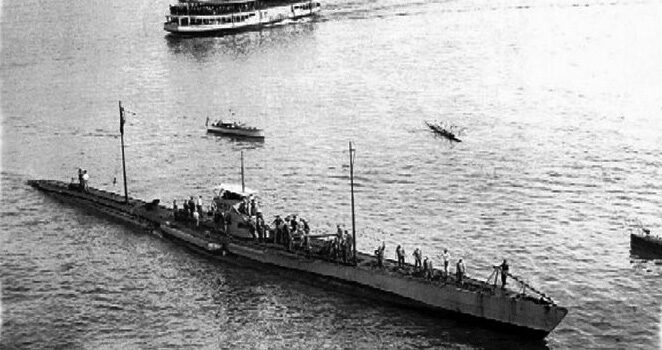
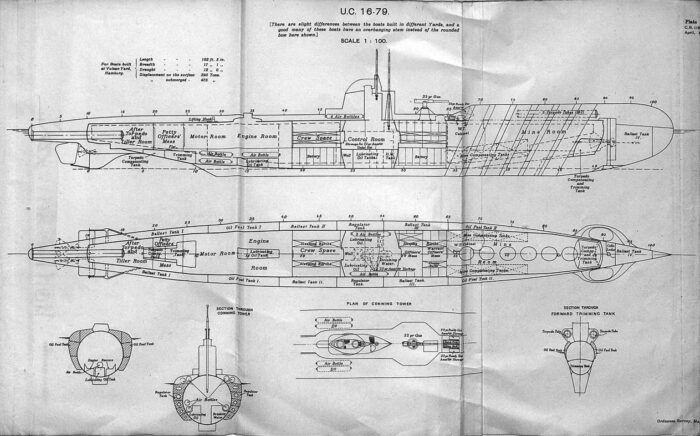
 Latest Facebook Entry -
Latest Facebook Entry -  X(Tweeter) Naval Encyclopedia's deck archive
X(Tweeter) Naval Encyclopedia's deck archive Instagram (@navalencyc)
Instagram (@navalencyc)





 French Navy
French Navy Royal Navy
Royal Navy Russian Navy
Russian Navy Armada Espanola
Armada Espanola Austrian Navy
Austrian Navy K.u.K. Kriegsmarine
K.u.K. Kriegsmarine Dansk Marine
Dansk Marine Nautiko Hellenon
Nautiko Hellenon Koninklije Marine 1870
Koninklije Marine 1870 Marinha do Brasil
Marinha do Brasil Osmanlı Donanması
Osmanlı Donanması Marina Do Peru
Marina Do Peru Marinha do Portugal
Marinha do Portugal Regia Marina 1870
Regia Marina 1870 Nihhon Kaigun 1870
Nihhon Kaigun 1870 Preußische Marine 1870
Preußische Marine 1870 Russkiy Flot 1870
Russkiy Flot 1870 Svenska marinen
Svenska marinen Søværnet
Søværnet Union Navy
Union Navy Confederate Navy
Confederate Navy Armada de Argentina
Armada de Argentina Imperial Chinese Navy
Imperial Chinese Navy Marinha do Portugal
Marinha do Portugal Mexico
Mexico Kaiserliche Marine
Kaiserliche Marine 1898 US Navy
1898 US Navy Sovietskiy Flot
Sovietskiy Flot Royal Canadian Navy
Royal Canadian Navy Royal Australian Navy
Royal Australian Navy RNZN Fleet
RNZN Fleet Chinese Navy 1937
Chinese Navy 1937 Kriegsmarine
Kriegsmarine Chilean Navy
Chilean Navy Danish Navy
Danish Navy Finnish Navy
Finnish Navy Hellenic Navy
Hellenic Navy Polish Navy
Polish Navy Romanian Navy
Romanian Navy Turkish Navy
Turkish Navy Royal Yugoslav Navy
Royal Yugoslav Navy Royal Thai Navy
Royal Thai Navy Minor Navies
Minor Navies Albania
Albania Austria
Austria Belgium
Belgium Columbia
Columbia Costa Rica
Costa Rica Cuba
Cuba Czechoslovakia
Czechoslovakia Dominican Republic
Dominican Republic Haiti
Haiti Hungary
Hungary Honduras
Honduras Estonia
Estonia Iceland
Iceland Eire
Eire Equador
Equador Iran
Iran Iraq
Iraq Latvia
Latvia Liberia
Liberia Lithuania
Lithuania Mandchukuo
Mandchukuo Morocco
Morocco Nicaragua
Nicaragua Persia
Persia San Salvador
San Salvador Sarawak
Sarawak Uruguay
Uruguay Venezuela
Venezuela Zanzibar
Zanzibar Warsaw Pact Navies
Warsaw Pact Navies Bulgaria
Bulgaria Hungary
Hungary

 Bundesmarine
Bundesmarine Dutch Navy
Dutch Navy Hellenic Navy
Hellenic Navy Marina Militare
Marina Militare Yugoslav Navy
Yugoslav Navy Chinese Navy
Chinese Navy Indian Navy
Indian Navy Indonesian Navy
Indonesian Navy JMSDF
JMSDF North Korean Navy
North Korean Navy Pakistani Navy
Pakistani Navy Philippines Navy
Philippines Navy ROKN
ROKN Rep. of Singapore Navy
Rep. of Singapore Navy Taiwanese Navy
Taiwanese Navy IDF Navy
IDF Navy Saudi Navy
Saudi Navy Royal New Zealand Navy
Royal New Zealand Navy Egyptian Navy
Egyptian Navy South African Navy
South African Navy






























 Ukrainian Navy
Ukrainian Navy dbodesign
dbodesign